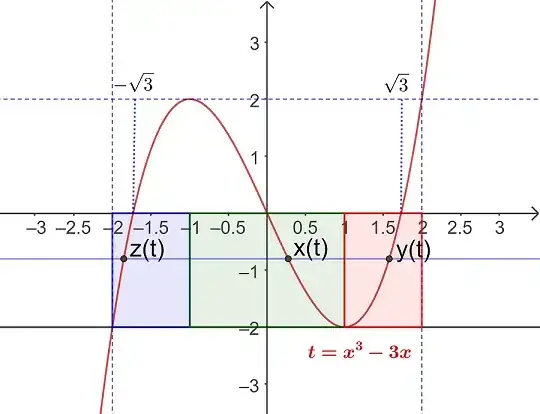Let $g:[-2, 2]\to\mathbb{R}$ be an even continuous function. Prove that $$\int_1^2g(x^3-3x)\,\mathrm dx=\int_0^1g(x^3-3x)\,\mathrm dx.$$
I found the following solution online, but I'm not sure why $$\int_0^1f(t)\,\mathrm d[x(t)]=\int_0^1 g(x^3-3x)\,\mathrm dx.$$ Also, why does $$\int_0^1g(t)\,\mathrm d[x(t)]=\int_{t=-1}^0 g(t)\,\mathrm d[y(t)]+\int_{t=-1}^0 g(t)\,\mathrm d[z(t)]\,?$$ Is it because $x(t) = -z(t)-y(t)$ and does $$\int_a^b\,\mathrm d(x(t))=-\int_a^b\,\mathrm d[y(t)]-\int_a^b\,\mathrm d[z(t)]\,?$$
For each $t\in [-1,0]$, the equation $x^3-3x=t$ has three roots $x(t)\in[0,1]$, $y(t)\in[1,\sqrt3]$, $z(t)\in [-2,-\sqrt3]$.
By Vieta's Theorem, $x(t)+y(t)+z(t)=0$ $\forall$ $t$. Also, $x^3-3x$ is differentiable on $\mathbb{R},$ increasing in $(-2,-\sqrt{3}), $ decreasing in $[0,1],$ and increasing in $[1,\sqrt{3}],$ so by the inverse function theorem, $x,y,z$ are all differentiable for $t\in (-1,0).$ We then have
\begin{align*} \int_0^1 g(x^3-3x)\,\mathrm dx&=\int_0^{-1}g(t)\,\mathrm d[x(t)]\\ &= \int_{-1}^0 g(t)\,\mathrm d[y(t)]+\int_{-1}^0g(t)\,\mathrm d[z(t)]\\ &=\int_1^{\sqrt3} g(y^3 -3y)\,\mathrm dy+\int_{-2}^{-\sqrt3}g(z^3- 3z)\,\mathrm dz\\ &=\int_1^{\sqrt3} g(y^3-3y)\,\mathrm dy + \int_{\sqrt3}^2g(z^3 - 3z)\,\mathrm dz&\text{(as g is even)}\\ &=\int_1^2 g(x^3-3x)\,\mathrm dx \end{align*}
